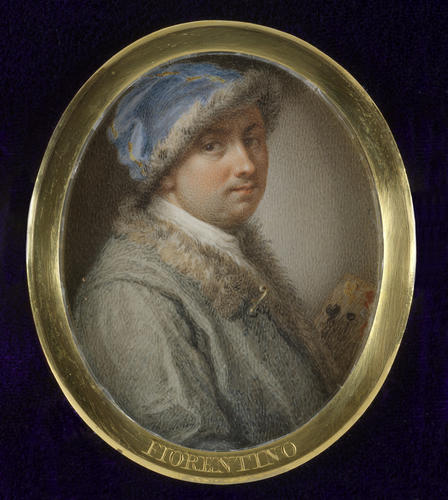Giuseppe Macpherson (1726-c. 1780)
Alessandro Gherardini (1655-c.1726) c.1770-80
7.0 x 5.7 cm (sight) | RCIN 421283
-
Alessandro Gherardini (1655-c. 1715) was a Florentine painter, much influenced by Paolo Veronese. He was, according to his biographer, Francesco Saverio Baldinucci, a difficult, unreliable character with a sometimes violent temper.When he was 20 years old he joined the Accademia del Disegno (drawing academy) then moved to Pontremoli. In 1682, he embarked on a study trip across Lombardy, probably visiting Venice, as his subsequent works reveal the influence of Venetian masters, and ended up in Parma. In 1687, he returned to Pontremoli where he married Francesca Calzolari, but shortly afterwards he left her, and moved to Livorno. In 1688, he returned to Florence, and received a commission from Ferdinando de' Medici to decorate a chapel in the Pitti palace. The artist completed it late and with such ill will that Ferdinando never employed him again. Gherardini painted altarpieces and portraits and undertook the decoration of churches and palaces in Italy, but felt his talent was not sufficiently recognised. He spent most of his final years in Livorno, believing he was going to be called to Denmark by King Frederick IV who had complimented him on his work. It is uncertain whether or not he did in fact make the journey, but Gherardini finally returned to Florence where he spent all his money turning his house there into a stables for the 12 horses and carriage he was convinced he was going to receive as a gift from the king of Denmark. Reduced to poverty, he requested a 200 scudi loan and, leaving his second wife and son only 25 scudi, he died in Livorno. There is a drawing of St Sebastian (RCIN 904583) attributed to Gherardini in the Royal Collection.
This miniature is one of the collection of copies of 224 self-portraits by artists in the Uffizi Palace, Florence, that Lord Cowper, the art collector and patron, commissioned Giuseppe Macpherson (1726-1780) to paint. He presented the miniatures to King George III in two batches, in 1773 and 1786. Macpherson followed the original self-portraits quite closely, but copied only the head and shoulders. He inscribed the artists' names on the backs of the miniatures – several differ from those in the modern Uffizi catalogue, notably: Bazzi, Bellini, Campi, Annibale Carracci, Gabbiani, Masaccio, Metsys, Moroni, Pencz, Licinio, Schiavone and Spada. None of the miniatures is signed, apart from Macpherson's own self-portrait, which is inscribed: Giuseppe Macpherson / Autore della serie (Giuseppe Macpherson / Author of the series).Macpherson was born in Florence, the son of Donald Macpherson, a footman in the service of Alexander, 2nd Duke of Gordon. He was a pupil of Pompeo Batoni and painted miniatures and enamel portraits in Italy, France and Germany, finally settling in Florence. A James Macpherson is recorded in London and Paris in 1754 but it is not certain that this is the same person. He was described in 1776 as having a special talent for painting on enamel and as being 'almost the only painter in Europe who possesses this art to perfection'. He had a distinguished client list which included some of the crowned heads and dignitaries of Europe. In 1778, he was invited to add his own self-portrait to the famous painters in the grand duke's collection as it 'would do honour to Florence to enrich the collection with a work which shows that we still have some men of true merit' according to Giuseppe Pelli, director of the Uffizi at the time.
Provenance
Presented to George III by Lord Cowper
-
Creator(s)
-
Medium and techniques
Measurements
7.0 x 5.7 cm (sight)
Category
Object type(s)










